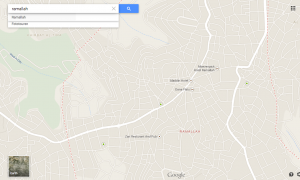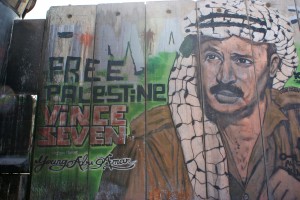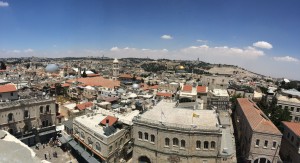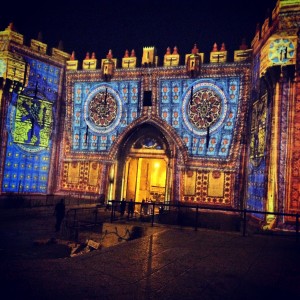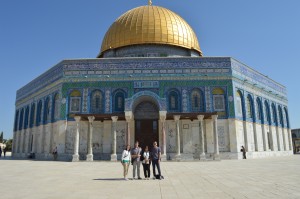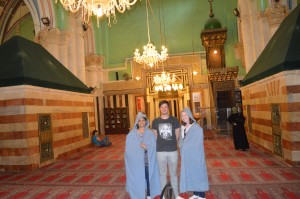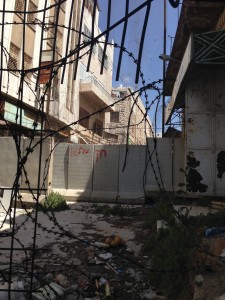Archive for category West Bank
Leaving…
Posted by Lukas Matzkows in Lukas Matzkows, West Bank on July 13, 2014
It has been a while since my last post. To be honest, my mind was preoccupied with other things lately. Now I am back in Germany and feel I should share my experiences of the last weeks in Jerusalem. I suppose that many of the people reading this blog also follow the news on our particular place in the world. Over the last weeks, the atmosphere in Jerusalem has changed significantly due to recent events. I will not even attempt to give a thorough summary of everything that happened, but I would still like to share some facts. On June 12th, three Israeli teenagers were kidnapped while hitchhiking in the occupied Palestinian territories, allegedly by Hamas (who have not taken responsibility for it). Israelis authorities then started a large scale police and military operation in the West Bank, searching for these teens. Over the next two weeks 350 Palestinians were arrested, dozens of houses demolished and five Palestinians killed in clashes between the IDF and protestors.
When the bodies of the three teenagers were found north of Hebron on June 30th, violence also spread to Jerusalem, when mobs of right wing Israelis roamed the streets looking for Arab workers. We coincided to walk past a rally, claiming “Kahane was right” and chanting “an Arab is a son of a bitch”. One of the places that was attacked, was the restaurant of our landlord for giving shelter to a Palestinian boy. On Facebook and other social media, campaigns started calling for revenge against the Palestinian people under #IsraelDemandsRevenge.
Two days later, the next despicable act followed, three Israelis kidnapped a 15-year-old Palestinian boy from the East-Jerusalem neighborhood of the Shuafat refugee camp, burned him alive and killed him in the woods outside the city. This act led to large scale protests in Shuafat, the West Bank and other parts of East Jerusalem. For more than two weeks now, parts of Israel and Palestine are burning every night. Every night we hear the sirens and the helicopters outside our apartment window, while Israel is preparing/carrying out the operation “Protective Edge”, which seems to aim at complete annihilation of Hamas in the Gaza Strip. By now, more than 120 Palestinians in Gaza have been killed and thousands injured.
The past events have made me question the use of the profession I chose. The indiscriminate hate for people based on their race I have seen in the faces of people makes me wonder whether there is any point in trying to find a just and peaceful solution. We came here five weeks ago, to document water issues in the West Bank and were given a first hand glimpse of the nature of the conflict. Our project here is over. People have other things to do than talking to us and the West Bank is not safe for us at the moment. On last Sunday we made the decision to leave the country, since it was completely unclear where this conflict is heading and we felt more and more useless, forced to sit at home and restricting ourselves to watching and reading the news. Personally it is a big disappointment. Ally and I were struggling a lot getting in contact with individuals willing to share their stories and now that we finally started to make some progress our contacts are being cut off. While I do not feel I was in danger, my family and friends were getting worried and urged me to come home. This also showed me how different the perceptions can be on the ground and far away only through the media. On Tuesday the first rockets hit Jerusalem and I for the first time in my life heard sirens telling me to look for shelter. However, everyone in the restaurant looked a little bit startled, but did not make any attempt to go anywhere and after a few minutes it was all over and people returned to business as usual. I guess people growing up and living in an environment of more or less constant conflict, experience these kind of things in a different way than us ‘outsiders’.
I left Jerusalem on Thursday with a bad feeling in my stomach. It is a feeling of giving up and leaving people behind. I knew when I came here, that I would not solve the conflict, yet the feeling stays. I am trying to tell myself that there was nothing I could have done and that leaving was the right decision, especially on hindsight.
For me, these events mean the end of my research project, for the people that stay there, it means a lot more.
Our first interview
Posted by Allison Collender in Ally Collender, West Bank on June 30, 2014
Today has been stressful, exciting, humbling, and heartbreaking.
Lukas and I started off the day super early to travel to meet with the Jordan Valley Solidarity Campaign. It was a whirlwind of an adventure – we took the bus from Jerusalem to Ramallah, then another bus from Ramallah to Nablus, then a taxi from the Nablus bus station to the Nablus taxi station, then finally a shared taxi to Tubas, a small city outside Nablus. From there we met with two people from the Campaign, and we drove out to the Jordan Valley. (Stress – check!)
The Valley itself is absolutely gorgeous. Everywhere you look there are beautiful mountains, and it was nice being away from a city from a bit. Lukas and I both want to see as much as the region as possible, and I am so glad we had the opportunity to come here. I’ve always been more of a fan of mountains than the ocean, and even though it was incredibly hot, I loved this region of Palestine. (Excitement – check!)
To the untrained eye you wouldn’t think that water was such a big issue here. And from reports, water shouldn’t be an issue. If there’s one area within Israel and the West Bank that should have plenty of water, it’s the Jordan Valley. Yet, for the 60,000 – 80,000 Palestinians living in the Valley, water is a scarcity that is quickly driving people from the region.
We had the opportunity to meet with one family and get our first interview! This family was so incredibly welcoming, and didn’t even bat an eye when we rolled up to their home. There were two young girls, around the ages of 2 and 3, who were eyeing us suspiciously at first, but by the end of our visit we were able to get them to smile and high five us. Even though they were celebrating Ramadan, they made us lunch, and made sure we had plenty of coffee, tea, and water to drink. After being with them for over 2 hours, I was incredibly sad to leave, but so thankful for the opportunity to meet these wonderful people. (Humbled – check)
Unfortunately, the good vibes did not last very long. As soon as we returned home to Jerusalem, we learned that the bodies of the 3 kidnapped Israeli teens were found in a ditch north of Hebron. As of now, Lukas and I are keeping an eye on the news, and staying in Jerusalem until tensions die down. As always, we are hoping for the best for all parties involved. (Heartbreak… check…)
First field trip on the schedule
Posted by Lukas Matzkows in Lukas Matzkows, West Bank on June 27, 2014
As Ally said in her last entry we have been struggling to get in touch with people on the ground for the last weeks. Coming to country with only a handful of personal contacts and a culture so different from the one at home proved to be quite a challenge, but also a learning experience for us. However, the last few days make us feel more optimistic about the upcoming second half of our fellowship.
On Monday we met with a German hydrologist, recommended by one of my professors, who has been living in Ramallah since 1997 and is well connected in the field. Finding his office was a task of his own and what Janine said about Yangon is certainly also true for the West Bank. People give you the name of a street and you think, I will just type that into Google Maps. Well, think again, Google Maps has almost no street names in Ramallah and finding an address by yourself is nearly impossible.
After he gave us a detailed description and drew a map for us we managed to find him and he was happy to help. He established connections for us to the people of the Jordan Valley Solidarity Campaign (http://jordanvalleysolidarity.org/), who we will visit on Monday in the small community of Fasayel, north of Jericho. In this particular area, water should be available in abundance, yet it is one of the regions suffering the most from limited supply. According to a survey of Save the Children UK, only 37% of the inhabitants have regular access to water resources
(http://www.savethechildren.org.uk/sites/default/files/docs/English_Jordan_Valley_Fact_Sheet_and_Citations.pdf).
It will be our first proper visit to the field and Ally and I are very excited, but also anxious about meeting people directly affected by water restrictions and shortages.
As Ally announced yesterday, in addition to the contacts established, we chose to have a change of strategy, away from e-mailing dozens of organisations that do not answer, towards a more direct approach of simply walking into their offices. We tried that strategy yesterday in Ramallah. and were not very successful. Of the two organisations we tried to meet, one said they cannot help us and at the other one nobody was there. Luckily, when we were about to leave Ramallah disappointed, Palestine showed itself to us from its best side again, in the form of its people. Ally and I decided to walk to the checkpoint, because we were more or less in between Qalandiya and the bus station and all busses that passed by were too full to take us. After walking for a while we heard constant honking behind us and saw a man in his lorry waving at us. His name was Hatem and he insisted to take us to the checkpoint. Although he hardly spoke any English and a conversation with our rudimentary Arabic was not really possible, we learned some things about him, exchanged phone numbers and saw again how kind and warm hearted the people of this country are.
Rethinking our strategy
Posted by Allison Collender in Ally Collender, West Bank on June 26, 2014
It’s been pretty difficult establishing contact with organizations or individuals in Israel and the West Bank. Lukas and I have reached out to so many organizations (at least 40 so far) that somehow deal with water issues, and only a small handful of those have replied. An even smaller amount has offered assistance. Needless to say, it’s been a little frustrating. There are so many groups affected by water, and there are so many problems surrounding water itself. People in East Jerusalem have a very different story than those who live in Area C in the West Bank. But the core issue is that many people aren’t receiving enough water. We’ve been told multiple times that there are 2.6 million people in the area with water issues. So where do we begin?
So, now we are back to square one, kind of. We’re going back through the list of organizations that we’ve contacted, and are planning on showing up to their offices and asking to speak to someone. The worst they can say is no. But with the organizations spread out over Ramallah, Bethlehem, Hebron, Jerusalem, and Tel Aviv, it’s a little difficult. And finding street addresses in the West Bank is nearly impossible. But we’re slowly working through it all and I feel confident with the direction we’re going. Regardless of what happens, at the end of this journey I will walk away having learned a lot about research, the Israeli-Palestinian conflict, and most importantly, myself.
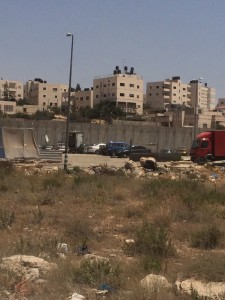
A picture from one of our adventures traveling into Ramallah. The concrete wall separates Israel from the West Bank.
Even though we’ve had some bumps in the road, we have had some good news as well. Lukas will be writing a blog post in a little bit sharing some of our successes.
All I buy is water…
Posted by Allison Collender in Ally Collender, West Bank on June 21, 2014
Every time I go outside, I am constantly thinking about when and where to buy a water bottle. I feel like all I buy here is something to drink.
Surprisingly, for a place that has so many issues with water, I can buy a water bottle for less than $3. Everything else here is expensive, especially food – average meals cost about 50 shekels (about $15). But water seems to be in abundance everywhere we go.
Today, while walking around Bethlehem, I stopped in a supermarket and grabbed a 1.5 liter water bottle, and when I went to the register the cashier told me I only had to pay 4 shekels. That’s about $1.15. I was floored – I knew water was cheap, but I wasn’t expecting it to be that cheap. Most places charge around 8 shekels for the same bottle.
We’ve heard stories from various people talking about how difficult it is to get water. People go months on end without having access to running water in their homes. They have to buy water off the black market just to be able to wash their dishes and take a shower. They spend time and money towards building illegal cisterns, only to be forced to destroy them when caught.
Yet all I have to do is spend a few shekels for a large water bottle. I can return to my apartment and know that I can brush my teeth before I go to sleep tonight. I can wake up in the morning and shower without thinking twice.
It’s amazing how traveling a couple of miles can so drastically change your access to such a precious resource.
A visit to the Shuk
Posted by Lukas Matzkows in Lukas Matzkows, West Bank on June 18, 2014
With tensions still tangible in many parts of the West Bank, Ally and I spent the last few days in Jerusalem. After visiting a former prison, yesterday, we decided to do something more joyful today and finally paid our first visit to the local Shuk we had heard so much about. The Shuk or Sooq often is the commercial center of North African and Middle Eastern cities, here in Jerusalem it is the central market. The Mahane Yehuda Shuk near the new city center around Jaffa and Ben Yehuda Street has existed in various forms for more than a hundred years and is a place to shop for both Jerusalemites and tourists. It is a world of its own, consisting of a number of small streets and alleyways packed wit people and delicacies.
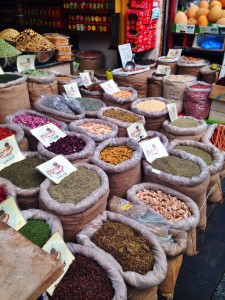
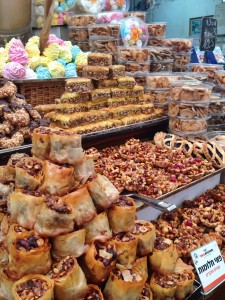
When we entered the roofed street of the market, we entered a beautiful place full of colors, smells and flavors. The market was full of people pushing through the narrow streets and we were overwhelmed by the variety of things on display. The smell of spices mixes with tea and fresh fruits and vegetables, while the ‘Halva King’ praises his latest creation. We wandered around the market for a couple of hours, only to take in the special atmosphere and in the end went home with some potatoes, fresh mint and lemons. There was just too much to chose from and we were not able to pick anything else from all these hundreds of stalls. Next time, that will be different.
Comfort in the Midst of Conflict
Posted by Allison Collender in Ally Collender, West Bank on June 15, 2014
Today marks two weeks since Lukas and I have arrived in Israel. It’s so weird typing that out… It feels like no time has passed at all. To think that 1/4 of this trip is already completed intimidates me. There is so much work we need to do research-wise, and there is so much more I want to experience. I swear, it feels like we arrived just a couple days ago.
It’s so strange how quickly I’ve become adjusted to this place. The other day while in Ramallah, we were trying to find a place to eat. It was overwhelming trying to find a place with hundreds of people walking around, and everything was in Arabic making it near impossible to find a place to sit down. My immediate response was, “Let’s go back to Jerusalem to eat.” Eventually we found a shawarma shop where one of the men working spoke English, and we were able to sit down and enjoy a good meal. But looking back, my reaction startles me. I haven’t been here that long, and when I’m in Jerusalem I still feel lost most of the time, yet I’ve become so comfortable here. Jerusalem has become my safety net.
This week has been the Festival of Lights in the Old City. All around the Jewish and Armenian quarters there are light projections on the walls and interesting art pieces around the streets. It’s so beautiful seeing the City lit up like this. The streets are filled with people, and there are even more carts than normal selling popcorn, cotton candy, and light-up toys. It’s been a lot of fun walking along the streets that we’ve become familiar with and seeing them in a new light (no pun intended… okay maybe that pun was slightly intentional).
While things seem fairly calm in Jerusalem, conflict is swarming around us. Earlier this week, 3 Israeli boys have gone missing in the West Bank while trying to hitch-hike outisde Hebron, and Israel believes that they have been kidnapped by Hamas. As I’m sure you gathered from Lukas’ post a few days ago, Hebron is already a very tense city – I cannot begin to imagine the energy moving through there now. In between football matches, Lukas will turn on the news to see if there are any updates about the missing boys. We are seeing this conflict evolve before our very eyes, and as a conflict analyst I am thrilled to be here experiencing it first-hand. But we are also very cautious – we’ve already decided that going back to Hebron would not be a smart decision at the moment. For now, we are staying informed, and hoping for the best for all parties.
West Bank and Israel – OMG!
Posted by Pushpa Iyer in Pushpa Iyer, West Bank on June 13, 2014
This was my first trip to Israel and the West Bank – well, in fact to the Middle East if I do not count my two-day trip in the late ’90s to Jordan! I had never imagined that I would enjoy the trip so much or that I would love the places I visited as much as I did, although I tore my hair with frustration with every sight and sound of the conflict that splits the people of this land.
Jerusalem and Bethlehem – so much history in one place! It was overwhelming to find myself standing in such historically significant places – what a privilege! Ally and Lukas were keen as one-week-old- hosts (although they have both been to the region before) to shown every place in these two cities that were important to anyone visiting.
We also went to Ramallah and Hebron. We planned to meet a colleague in an international NGO in Ramallah but Hebron happened simply by chance. We ran into a staff member of a Palestinian local organization and accepted his invitation to travel to Hebron.
Traveling to Palestinian controlled areas of Bethlehem, Ramallah and Hebron was such an experience. We saw with our own eyes every little indication of the conflict (and this included water conflicts), the incredible amount of violence that at this time definitely seemed one sided and against the Palestinians and we witnessed and experienced the indignities of passing through check points every time we returned to Jerusalem from the Palestinian controlled areas. And of course the separation wall was central to our separate experiences of Israel and Palestine.
So beautiful a region, such warm people… yet so harsh, so violent and so ghettoized. I kept wondering – why? Why is the human race so stupid? Why is the human race so cruel? Why is the human race so violent? Why is the human race so unforgiving? Why is the human race so determined to commit the same crimes of the past?
The last question hit me in the head, as a hammer would hit a nail when I toured the holocaust museum – Yad Vashem – Israel’s Memorial for the Jewish victims of the Holocaust. Why when the past shows how cruel, wrong, and despicable humans have been, are some of us so determined to continue the tradition today?
I have so many thoughts. So many feelings. I have emotions to sort through. I have so much more to write….but not I until I process my thoughts more.
The divided city of Hebron
Posted by Lukas Matzkows in Lukas Matzkows, West Bank on June 12, 2014
The last week was incredibly busy and so full of unforgettable impressions that I struggle with structuring all the thoughts in my head and write them down. One of the many places we visited, was the city of Hebron. It is one of Palestine’s biggest cities, located in the south of the West Bank. It is a city with a beautiful old city center, a once busy market and it is home to the tombs of Abraham, Sara and Isaac, which makes it a holy place for all of three religions in this country. It is also a city of division and conflict. Since 1979 religious jews have settled in and around the city and today the old town is home to around 30.000 Palestinians and 800 settlers. The city is divided in the areas H1, under Palestinian control, and H2, under full control of Israeli authorities.
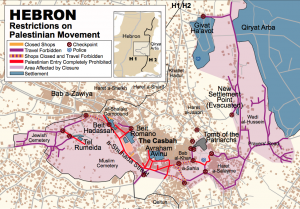
(https://www.btselem.org/download/200705_hebron_center_map_eng.pdf)
We entered the city with our guide Usama, from the Palestinian Conflict Transformation Center Wi’Am(which is Arabic for cordial relationships), who had a few heartbreaking stories to tell about his family and the ramifications of the ongoing conflict. He led us to the main street where at the first glimpse you would think it is a normal busy oriental city, but when you look up you notice something is different. The whole market area has an overhead fence which is bending down from the weight of litter. It has been set up by TIPH, an international observer mission that first came to Hebron following a massacre at the local mosque that left 29 male worshippers dead and 125 wounded. The fence protects the market from settlers who live on the second floor and through things at people and goods on display.
After that impression we visited the house of a friend of Usama. He lives almost wall on wall with settlers in Beit Hadassah. From his roof you can see Shuhada-Street, once a vibrant street where jewelers sold their goods. Today, the street is under full control of the settlers and Palestinians are not allowed to set foot in it anymore. Parts of it are completely shut down, in the rest, access is limited to Israelis. Shopkeepers that had their businesses here for generations had to abandon their shops and houses which led to an increase of unemployment and poverty. According to the UN, 75% of Palestinian residents of the old Souk area live under the poverty line. Usama’s friend told us stories and showed us videos of settlers climbing onto his roof to take down the Palestinian flag while soldiers stand by and watch. Standing on this roof, we could feel the tension that is all time present in this city and I was somewhat relieved once when we climbed down.
Our next stop, after crossing two more security checkpoints, was the beautiful Ibrahimi Mosque that has its own history. Following the events of 1994, the mosque was, as the city, divided. 40% remained a mosque, while 60% became a synagogue. Access to the mosque is completely controlled by the Israeli army, and completely restricted on jewish holidays. Inside we found stunning mosaics, paintings and the memorials of Abraham and Sara.
After that, we left the city the way we came, under the protection of the fence above.
Adventures in Jerusalem
Posted by Allison Collender in Ally Collender, West Bank on June 6, 2014
Over the past few days, Lukas and I have had the opportunity to do even more sight-seeing!
Yesterday we spent time at the Garden Tomb, which is where some Christians believe that Jesus was buried after his crucifixion. The other well-known location of where the burial might have taken places is located at the Church of the Holy Sepulchre, which we have been waiting for Pushpa to arrive for us to visit. The Garden Tomb was incredibly peaceful. Like the name suggests, is a very large garden on the outskirts of the Old City. They also offer free tours, which was great because most of the sightseeing Lukas and I have done has been on our own. It was nice for someone to tell us stories, rather than rely on our memories of our previous visit.
This morning, we decided to go on the Rampart Walk, which is a catwalk that goes around the perimeter of the Old City. There are technically two different sections of the Walk, but unfortunately one end was closed off, but we still enjoyed ourselves. We ended up making friends with 3 couples who were on a tour group together, and had some free time before the left to explore the Old City. After we finished the Walk, we showed them some other areas of the Old City they hadn’t seen before, like the overlook of the Western Wall. It’s really surprising how quickly Lukas and I have learned our way around the place. Okay, maybe I haven’t really gotten the directions sorted out, but I can always rely on Lukas to figure out the right way to go! Below is a picture of us on the Rampart Walk.
This evening, Pushpa arrived to visit us! After grabbing some falafel for dinner, we decided to give her a mini-tour of the Old City. Like we did with our friends before, we took her to see the overlook of the Western Wall. Shabbat, the Jewish holy day, began tonight at sundown, so there were so many people at the Western Wall praying. And while we were watching, the Muslim call to prayer began to play as well. I cannot begin to describe how amazing it was to experience both of these religious ceremonies occur at the same time. Israel has such a wide array of culture, but it’s often divided amongst religious sects. It was beautiful to see these two religious groups overlap one another.
Tomorrow we will be going to visit Bethlehem, where we will see the Church of the Nativity and walk along the Separation Wall and see all the graffiti. The graffiti is absolutely incredible, and I am sure we will have some good pictures and stories to share from that trip.

